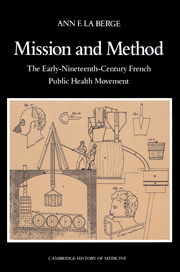Book contents
- Frontmatter
- Contents
- List of tables and illustrations
- Preface
- Acknowledgments
- Introduction
- I Community, method, context
- II Carrying out the mission: Institutionalization, investigation, moralization, and practical reform
- Chapter 4 Institutionalization: The health councils
- Chapter 5 Investigation and moralization: Occupational hygiene and industrialization
- Chapter 6 Investigation and practical reform: Public health in Paris
- Chapter 7 Public health in Paris: Investigation, salubrity, and social welfare
- III Public health before Pasteur
- Epilogue
- Appendixes
- Bibliographical Note
- Index
Chapter 5 - Investigation and moralization: Occupational hygiene and industrialization
Published online by Cambridge University Press: 17 September 2009
- Frontmatter
- Contents
- List of tables and illustrations
- Preface
- Acknowledgments
- Introduction
- I Community, method, context
- II Carrying out the mission: Institutionalization, investigation, moralization, and practical reform
- Chapter 4 Institutionalization: The health councils
- Chapter 5 Investigation and moralization: Occupational hygiene and industrialization
- Chapter 6 Investigation and practical reform: Public health in Paris
- Chapter 7 Public health in Paris: Investigation, salubrity, and social welfare
- III Public health before Pasteur
- Epilogue
- Appendixes
- Bibliographical Note
- Index
Summary
Before 1850, most French workers were employed in traditional artisanal industries located in small workshops and workers' cottages, but some areas of northern France, namely, the Nord, Loire, Seine-Inférieure, Alsace, and greater Paris industrialized rapidly. Both handcraft and domestic industries and new mechanized, factory-based industries attracted the attention of sociomedical investigators. Industrialization generated a new interest among public hygienists and social reformers in the health of the working classes, because it seemed to threaten the health of factory workers. Statistics gathered in England and France showed that mortality was much higher in industrial than agricultural areas and that army rejections were greater among the working classes than among the comfortable classes. Hygienists and reformers investigated the condition of the working class to determine how industry and industrialization affected workers' health. At stake, hygienists believed, was the military and productive strength of the nation.
Hygienists identified two principal ways in which industry could affect workers' health: Industrial and occupational processes and working conditions in factories and workshops could cause health problems; and workers' living conditions could affect their health directly or indirectly. Although the hygienists' role was primarily investigative, they advocated socioeconomic reform and legislative measures to improve workers' health. Underlying their recommendations was the strong need for moral reform, or the moralization of workers. This was especially true in the case of Villermé. Sociomedical investigations led to increased awareness of industrial health problems, but they did not lead to effective national legislation.
- Type
- Chapter
- Information
- Mission and MethodThe Early Nineteenth-Century French Public Health Movement, pp. 148 - 183Publisher: Cambridge University PressPrint publication year: 1992

